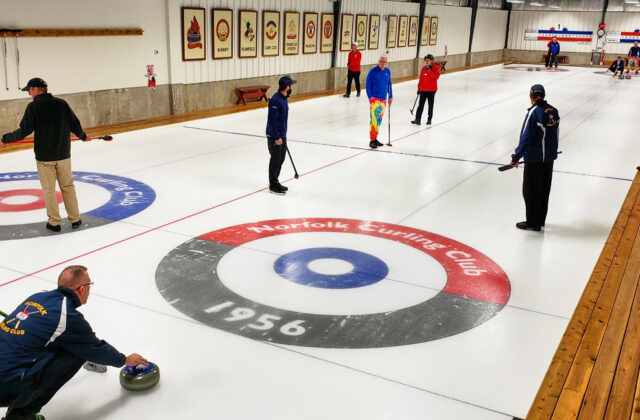Curling Club Planning for Reopening in Mid-January
Shorter season will run to Mid-April
Text by Ruth Melville
Photo courtesy of the Norfolk Curling Club
On March 15, the pandemic forced the Norfolk Curling Club to close abruptly, cutting short its season. Since then, club members, under the direction of the executive board and president Bob Gilchrest, have been working hard to develop a plan for how they could safely reopen and salvage part of their 2020/2021 curling season.
To devise a reopening strategy, the club had to take into consideration both current state guidelines and the financial realities of keeping the club going. The curling club is classified as a “sporting club,” which puts them in the same category as gyms and fitness centers. As of this writing, Connecticut is in Phase 2 of its reopening plan, which means that such organizations are allowed to reopen, but only if they follow certain rules in regard to hygiene, physical distancing and facility capacity.
The annual expenses of the curling club are funded by membership fees, bonspiels, Learn to Curl clinics, rentals and fund-raising. This year, however, the only money coming in will be from members’ fees and fundraising. As Gilchrest says, “There’s a portion of that revenue we’re not going to see this year. We’re taking a big hit.”
From day one, Gilchrest says, the decision process was “all about transparency, everybody had a voice.” The board wanted members to know what their choices were and what other clubs were considering doing—some have decided not to open at all this upcoming season.
The executive board set up workgroups to come up with recommendations for the various aspects involved in reopening: membership, building operations, finances, league play. The club sent out a several rounds of surveys to all 125 club members to facilitate discussion. The first survey was simply to find out what the members were thinking. Did the membership want to return? Were they willing to sacrifice some aspects of a normal season to be able to reopen? Having received positive feedback, the board send out further surveys with more detailed questions.
The club soon realized it couldn’t open in October as normal. Taking into consideration the results of the surveys, the health and safety of the members and financial issues,
the club decided that the best scenario would be to try for a modified opening. The plan, which is still being worked out in detail, calls for the season to run from the middle of January to the middle of April.
There’s no question that things will look different. There will be internal league play only, limited to club members. The warm room will be open just for changing shoes and getting on the ice, so players will have to arrive dressed to play. Draw times (game times) will be staggered, allowing for cleaning between each draw. There will be no spectators or congregating in the club house, and the bar and kitchen will remain closed. State guidelines for cleaning public areas, maintaining social distancing and wearing masks will be adhered to.
Play will look a bit different on the ice as well. The normal two sweepers will be cut to one, since sweepers work in close proximity to each other and breathe heavily—and there will be some physical distancing during play.
Gilchrest knows that the new restrictions will be hard on some members, but he says, “We have to follow state directives, we must protect the club.” The health and safety of the members and their extended families must be the most important consideration.
But he also sees a positive side to the current situation. “It’s a chance to think outside the box. I see a great opportunity here for education.” With fewer sweepers, throwers will have to work on their “weight,” or the amount of force given to the stone during delivery. Members will have a chance to improve their mechanics and learn to communicate more by signaling rather than shouting—something Gilchrest says is done at the elite level of the sport.
“I’m excited about trying this out,” he says. “I think it can still be fun and competitive. It’s not all doom and gloom. This could be a season we can remember and know that we thrived in spite of obstacles. We need to put things in perspective. For us to have an opportunity to open, even if in a modified form, is a gift.”
Update: Governor Lamont has just announced that Connecticut will move to Phase 3 of reopening on Oct. 8, which will increase indoor capacity.

